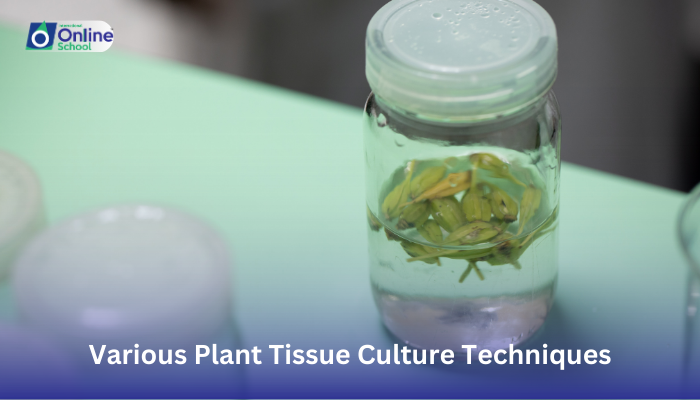
Learning Outcomes:
i. Describe and differentiate between four key plant tissue culture techniques: anther culture, ovary culture, meristem culture, and embryo culture.
ii. Understand the specific plant tissues used in each technique and their potential for regeneration and development.
iii. Appreciate the diverse applications of these techniques in fields like agriculture, horticulture, and plant breeding.
Introduction:
Imagine a workshop where tiny bits of plants, like pollen grains or embryos, hold the potential for a multitude of offspring. This isn't magic, but the remarkable world of plant tissue culture, where scientists utilize specialized techniques to manipulate plant growth and development. Today, we delve into this green toolbox, exploring four key techniques that unlock the hidden potential within different plant tissues.
i. Anther Culture: Pollen Power for Double Duty:
In this technique, pollen grains, the male reproductive cells found in anthers, are cultured on special media under controlled conditions. These pollen grains, surprisingly, can develop into haploid plants, containing only half the usual number of chromosomes.
Think of pollen grains as seeds carrying the blueprint of just one parent. Through this technique, scientists can create new lines of plants with unique genetic combinations, valuable for plant breeding and research.
ii. Ovary Culture: Saving Seeds Before They Form:
Ovary culture involves isolating and cultivating immature ovules, the female reproductive structures inside the ovary, before they develop into seeds. This allows for the regeneration of plants from ovaries that might not produce viable seeds otherwise.
Imagine rescuing the potential of a plant even before the seed is formed. This technique is crucial for propagating rare or endangered plants with low seed viability and for producing hybrid plants with desirable traits.
iii. Meristem Culture: A Clean Start from the Tip:
Meristem culture focuses on the very tip of growing shoots, a region containing rapidly dividing cells called meristems. These tiny pieces are isolated and cultured on special media, eventually developing into complete plantlets.
Think of the meristem as the heart of growth, holding the blueprint for the entire plant. This technique is ideal for producing disease-free plants, as the meristems are often free of viruses and other pathogens present in other plant tissues.
iv. Embryo Culture: From Tiny Seedlings to Full-Fledged Plants:
Embryo culture involves rescuing and nurturing immature embryos from developing seeds. These embryos are cultured on nutrient-rich media under controlled conditions, eventually maturing into complete plantlets.
Imagine giving a helping hand to seedlings stuck in the early stages of development. This technique is helpful for propagating recalcitrant plant species with seeds that are difficult to germinate or store, and for overcoming seed dormancy.
Anther culture, ovary culture, meristem culture, and embryo culture – these are just a few tools in the diverse toolbox of plant tissue culture. Each technique unlocks the unique potential within specific plant tissues, offering a multitude of applications in agriculture, horticulture, and plant research. By appreciating the power and precision of these techniques, we can contribute to the development of new, improved varieties of plants, enhance food security, and safeguard biodiversity for generations to come.